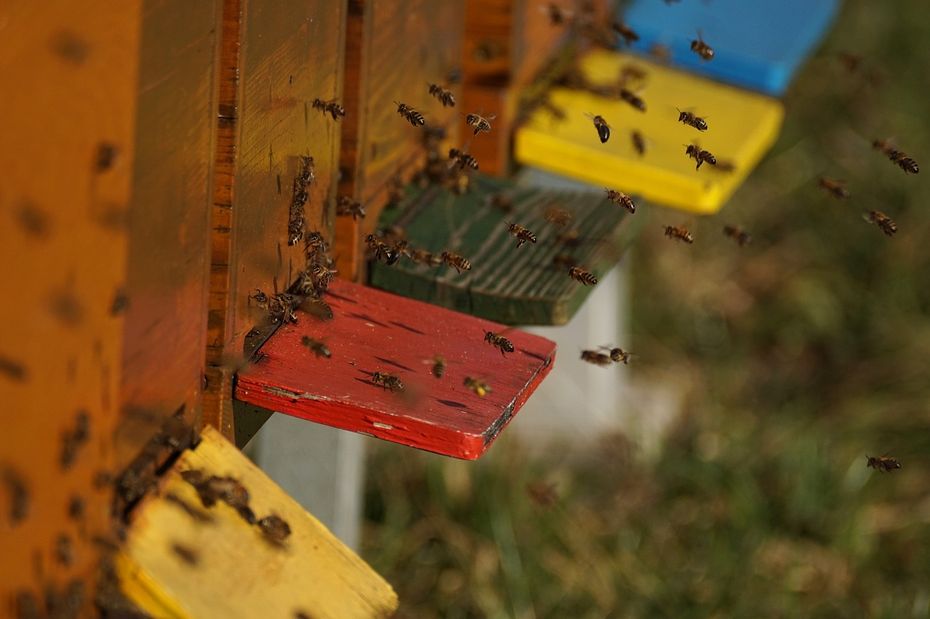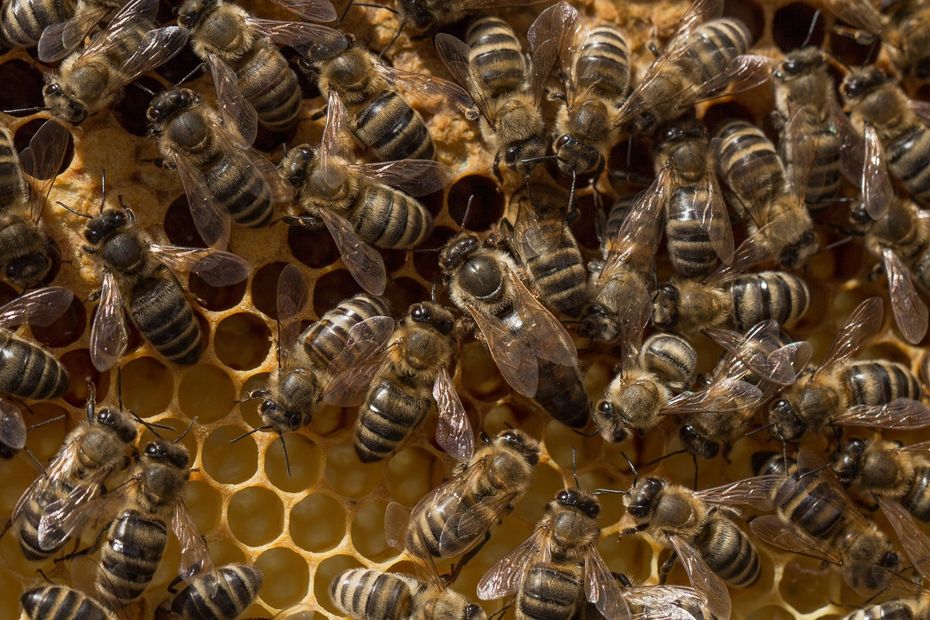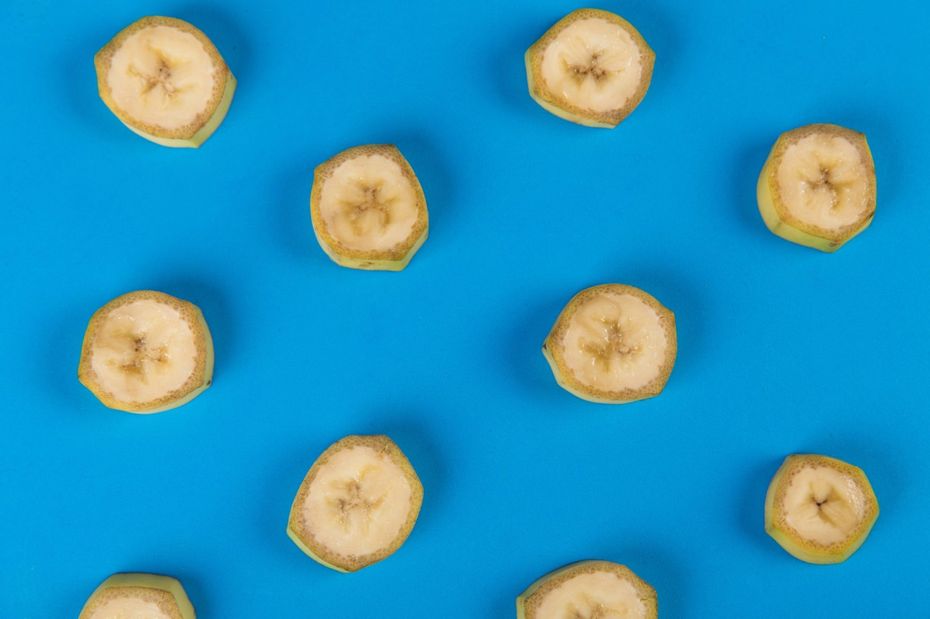It is said that bananas and bees are not a good combination and one should not be standing near a beehive when eating a banana. Why is it that this piece of fruit is believed to trigger such a response?

To answer this question, we will have to take a closer look how bees send and interpret signals of their peers. To keep the bee colony functioning smoothly, honey bees communicate extensively with each other. They share the location of promising food sources, raise alarm when the hive is threatened, indicate the condition of the queen and many more. Effective communication is what makes honeybees such strong and efficient animals. But how do they do this exactly?
Pheromones
Bees communicate by releasing so-called pheromones. Pheromones are chemical substances that are released by an animal in order to influence the behavior of its peers [1]. The use of pheromones is widespread in the animal kingdom and even humans might use them. Take for example deodorant advertisements, which typically show that hundreds of people find you suddenly attractive after you used one of their products. Although it is clear these advertisements do not represent real life (scientist are debating the existence of human pheromones [2]), they do so in the world of bees. The sense of a particular pheromone can evoke an instant response. For example, when a honey bee stings the ‘alarm pheromone’ is released which immediately causes other bees to act aggressive as well.
Honey bee pheromones
Honeybees possess one of the most sophisticated pheromone communication systems in the animal kingdom. Pheromones can have multiple and far-reaching influences on bees. They do not only affect bees behavior, but some can even change their physique. These pheromones are called ‘primer pheromones’ and have strong and long-term effects. ‘Releaser pheromones’ on the other hand have only a short-term effect and only influence behavior [1]. Most releaser pheromones are released by worker bees or drones, while the queen secretes most of the primer pheromones.
Queen bee pheromones
The queen uses a wide array of pheromones to regulate the colony. Without this, the colony would quickly disintegrate and fall into chaos. Each queen bee secretes her own unique sense. When a new queen has to be introduced to a colony (for example when a beekeeper wants to replace an old queen), she has to be kept in a separate cage within the hive for a few days, to give the bees the opportunity to familiarize themselves with her smell.

The queen signal
The most important pheromone is the so-called queen mandibular pheromone. This is actually a set of multiple pheromones which regulate life in the colony. Firstly, it secures the position of the queen in the colony by preventing other female bees to develop into queens. Various primer pheromones inhibit the ovary development of female worker bees. Furthermore, she discourages the rearing of new queens. The sense of the queen also attracts male drone bees for mating. Secondly, These senses also serve regulate life of the other bees. It stimulates worker bees to do their tasks like caring for brood, building, foraging, guarding etc. When a queen grows older, the intensity of the queen signal drops, this causes workers bees to rear new queens.
Queen retinue pheromone
Another set of pheromones is the queen retinue pheromone, this pheromone attract bees to serve as retinue for the queen. This retinue of worker bee will care for her well-being and feed and groom her.
Worker and drone bee pheromones
The alarm pheromone: This pheromone is released when a bee stings and will attract other bees to this location and act defensively. Because of this pheromone, beekeepers use smoke when they are working with bees. The smoke will mask the sense of the alarm pheromone.
Orientation, Nasonov Gland: Named after scientist Nasonov, this sense is used to give direction. Bees at the entrance of the hive might secrete it, in order to direct other members of the colony back to the hive. However bees might use it in various circumstances when they try to attract bees to a certain location. To release this pheromone, bees put their abdomen in the air and use their flap their wings to spread the sense [3].
Brood recognition: This is emitted by larvae and helps worker bees distinguish between worker bee and drone larvae.
Drone pheromone: Drones emit this pheromone to attract other drones. They huddle together in areas suitable for mating with the queen bee.
Forager pheromone: The task of worker bees is determined by her age, older forager bees release this pheromone to slow down the maturing of younger nurse bees. In this way, this primer pheromone keeps the amount of nurse and forager bees in balance [4].
Bees and banana’s

So how does all this talk about pheromones relates to banana’s and bees? Apparently the alarm pheromone smells a bit like banana [5]. The alarm is released when a bee stings and will attract other bees to this location and act defensively. So, the smell of banana’s might attract a group of angry bees. When googling banana’s and bees one can find numerous claims or examples that one should not be near bees however it has to be noted that no study has backed this claim. The description of this effect really is a bit vague. However it is safe to say that there is no need to be afraid to get swarmed by aggressive bees while eating your banana outside. However, when you are near a hive, it might be wise to keep your banana unpeeled.
Literature
[1] Bortolotti, L., & Costa, C. (2014). Chemical communication in the honey bee society. In Neurobiology of chemical communication. CRC Press/Taylor & Francis.
[2] Kwon, D. (2018). Do Human Pheromones Exist? The Scientist. Retrieved from: https://www.the-scientist.com/news-analysis/do-human-pheromones-exist-30381
[3] Free J.B, Ferguson A.W, Pickett J.A. (1981). Evaluation of the various components of the Nasonov pheromone used by clustering honey bees. Physiol Entomol. 6 (3) 263–68.
[4] Leoncini, I., Le Conte, Y., Costagliola, G., Plettner, E., Toth, A. L., Wang, M., … & Robinson, G. E. (2004). Regulation of behavioral maturation by a primer pheromone produced by adult worker honey bees. Proceedings of the National Academy of Sciences, 101(50), 17559-17564.
[5] Slessor, K. N., Winston, M. L., & Le Conte, Y. (2005). Pheromone communication in the honeybee (Apis mellifera L.). Journal of chemical ecology, 31 (11), 2731-2745.